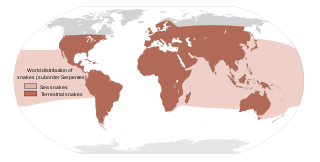This is an index of lists of people by cause of death, in alphabetical order of cause.

A shark attack is an attack on a human by a shark. Every year, around 80 unprovoked attacks are reported worldwide. Despite their rarity, many people fear shark attacks after occasional serial attacks, such as the Jersey Shore shark attacks of 1916, and horror fiction and films such as the Jaws series. Out of more than 500 shark species, only three are responsible for a double-digit number of fatal, unprovoked attacks on humans: the great white, tiger, and bull. The oceanic whitetip has probably killed many more shipwreck and plane crash survivors, but these are not recorded in the statistics. Humans are not part of a shark's normal diet. Sharks usually feed on small fish and invertebrates, seals, sea lions, and other marine mammals. A shark attack will usually occur if the shark feels curious or confused.

A snakebite is an injury caused by the bite of a snake, especially a venomous snake. A common sign of a bite from a venomous snake is the presence of two puncture wounds from the animal's fangs. Sometimes venom injection from the bite may occur. This may result in redness, swelling, and severe pain at the area, which may take up to an hour to appear. Vomiting, blurred vision, tingling of the limbs, and sweating may result. Most bites are on the hands, arms, or legs. Fear following a bite is common with symptoms of a racing heart and feeling faint. The venom may cause bleeding, kidney failure, a severe allergic reaction, tissue death around the bite, or breathing problems. Bites may result in the loss of a limb or other chronic problems or even death.
There have been many toilet-related injuries and deaths throughout history and in urban legends.

A dog bite is a bite upon a person or other animal by a dog, including from a rabid dog. More than one successive bite is often called a dog attack, although dog attacks can include knock-downs and scratches. Though some dog bites do not result in injury, they can result in infection, disfigurement, temporary or permanent disability, or death. Another type of dog bite is the "soft bite" displayed by well-trained dogs, by puppies, and in non-aggressive play. Dog bites can occur during dog fighting, as a response to mistreatment, by trained dogs working as guard, police or military animals, or during a random encounter.

Crocodile attacks on humans are common in places where large crocodilians are native and human populations live. It has been estimated that about 1,000 people are killed by crocodilians each year.
A man-eater is an individual animal or being that preys on humans as a pattern of hunting behavior. This does not include the scavenging of corpses, a single attack born of opportunity or desperate hunger, or the incidental eating of a human that the animal has killed in self-defense. However, all three cases may habituate an animal to eating human flesh or to attacking humans, and may foster the development of man-eating behavior.

A traffic collision, also known as a motor vehicle collision, occurs when a vehicle collides with another vehicle, pedestrian, animal, road debris, or other moving or stationary obstruction, such as a tree, pole or building. Traffic collisions often result in injury, disability, death, and property damage as well as financial costs to both society and the individuals involved. Road transport is statistically the most dangerous situation people deal with on a daily basis, but casualty figures from such incidents attract less media attention than other, less frequent types of tragedy. The commonly used term car accident is increasingly falling out of favor with many government departments and organizations, with the Associated Press style guide recommending caution before using the term. Some collisions are intentional vehicle-ramming attacks, staged crashes, vehicular homicide or vehicular suicide.
An occupational fatality is a death that occurs while a person is at work or performing work related tasks. Occupational fatalities are also commonly called "occupational deaths" or "work-related deaths/fatalities" and can occur in any industry or occupation.

Wildlife attacks in Australia occur every year from several different native species, including snakes, spiders, freshwater and saltwater crocodiles, various sharks, cassowaries, kangaroos, stingrays and stonefish and a variety of smaller marine creatures such as bluebottles, blue-ringed octopus, cone shells and jellyfish.

Worldwide, it was estimated that 1.25 million people were killed and many millions more were injured in motor vehicle collisions in 2013. This makes motor vehicle collisions the leading cause of death among young adults of 15–29 years of age and the ninth most frequent cause of death for all ages worldwide. In the United States, 40,100 people died and 2.8 million were injured in crashes in 2017, and around 2,000 children under 16 years old die every year.

Fatal Attractions is a recurring documentary program that was broadcast on Animal Planet. First aired in 2010, the show focused on humans who have kept animals as unconventional pets that have turned out to be dangerous and sometimes fatal. The program's last new episode aired in February 2013.

Most snakebites are caused by non-venomous snakes. Of the roughly 3,700 known species of snake found worldwide, only 15% are considered dangerous to humans. Snakes are found on every continent except Antarctica. There are two major families of venomous snakes, Elapidae and Viperidae. 325 species in 61 genera are recognized in the family Elapidae and 224 species in 22 genera are recognized in the family Viperidae, In addition, the most diverse and widely distributed snake family, the colubrids, has approximately 700 venomous species, but only five genera—boomslangs, twig snakes, keelback snakes, green snakes, and slender snakes—have caused human fatalities.

A total of 24 people have been killed by sharks in South Australian waters since the establishment of the colony in 1836. Prior to 2014, there had been 82 recorded shark attacks in South Australia. 20 of those have involved a single fatality. Victims were involved in a range of aquatic activities, including surfing, diving, spear-fishing, snorkeling, boating and swimming. Six of the fatalities occurred off the coast of greater metropolitan Adelaide, with the remainder distributed across South Australia's extensive coastline. Many of the fatal attacks have been attributed to great white sharks.

Sportspeople who died during their careers are covered in lists by sport, and in the case of motorsports by location.

Animal attacks are violent attacks caused by non-human animals against humans, one of the most common being bites. These attacks are a cause of human injuries and fatalities worldwide. According to the 2012 U.S. Pet Ownership & Demographics Sourcebook, 56% of United States citizens owned a pet. In the United States in 1994, approximately 4.7 million people were bitten by dogs. The frequency of animal attacks varies with geographical location, as well as hormonal secretion. Gonad glands found on the anterior side of the pituitary gland secrete androgen and estrogen hormones. Animals with high levels of these hormones, which depending on the species can be a seasonal occurrence, such as during rutting season, tend to be more aggressive, which leads to a higher frequency of attacks not only to humans but among themselves. In the United States, a person is more likely to be killed by a domesticated dog than they are to die from being hit by lightning according to the National Safety Council.
Fatal dog attacks are human deaths caused by dogs. The study of fatal dog attacks can lead to prevention techniques which can help to reduce all dog bite injuries, not only fatalities. Dog bites and attacks can result in pain, bruising, wounds, bleeding, soft tissue injury, broken bones, loss of limbs, scalping, disfigurement, life-threatening injuries, and death.

List of reported attacks and species involved in Latin America.